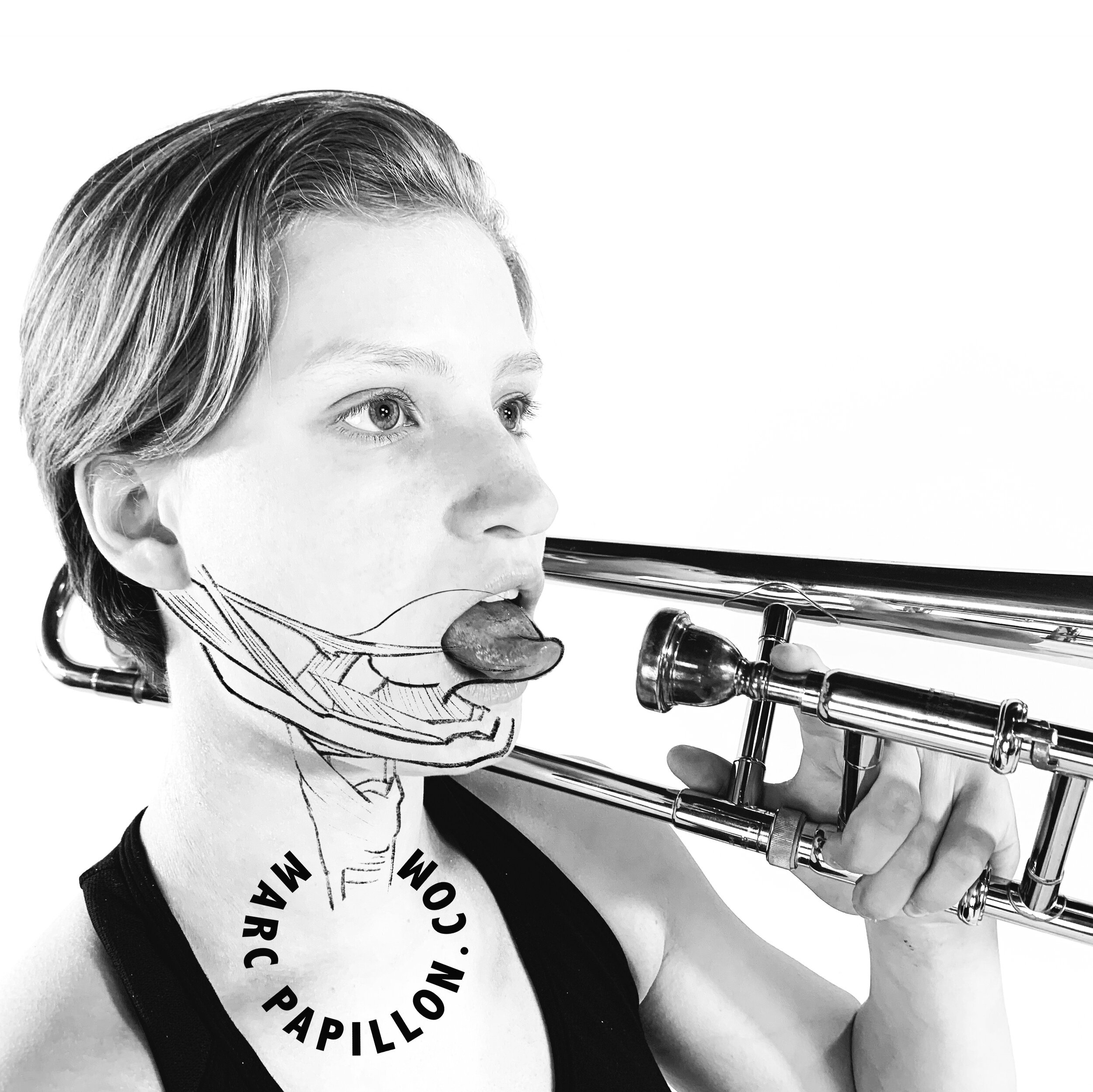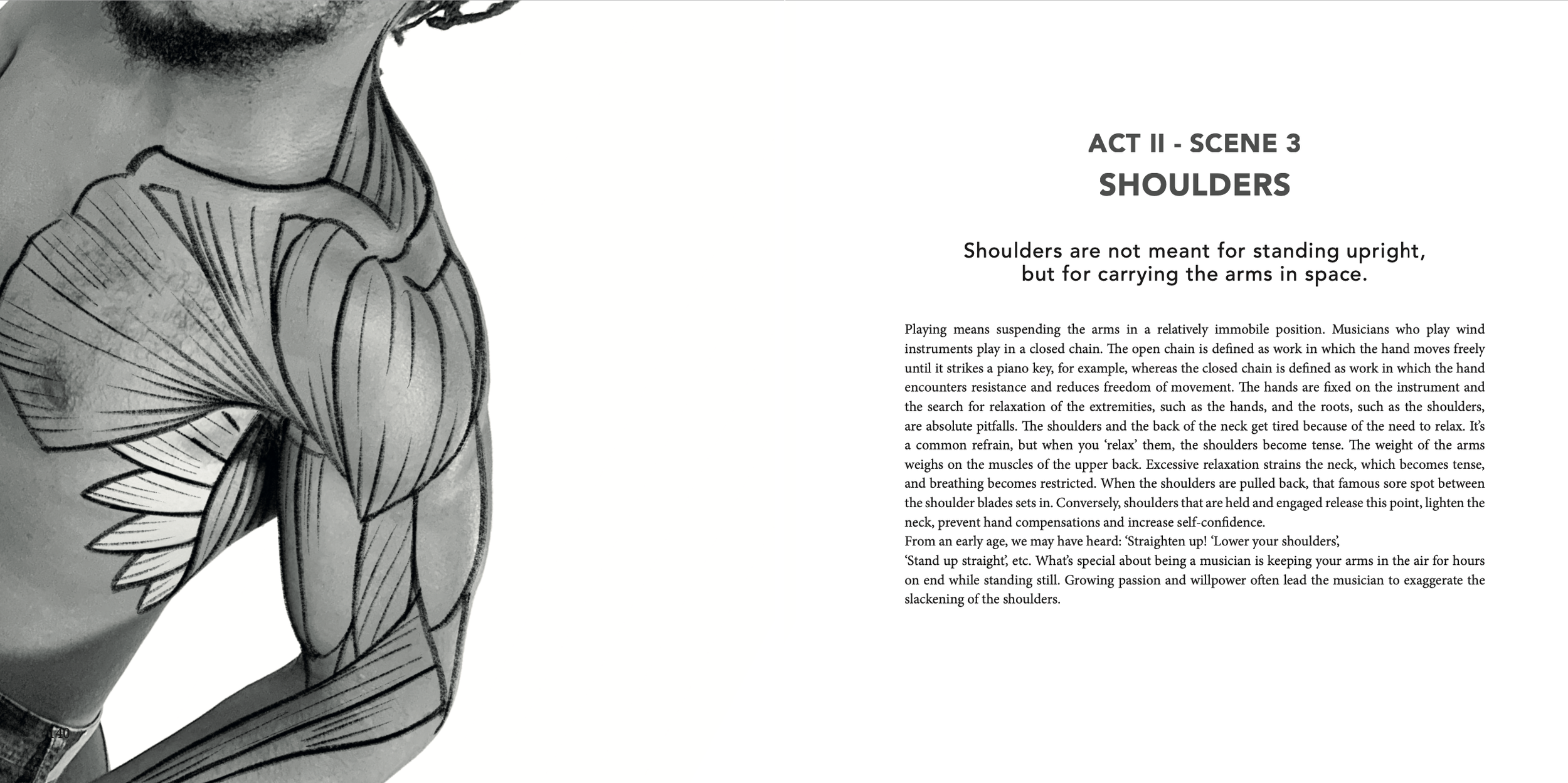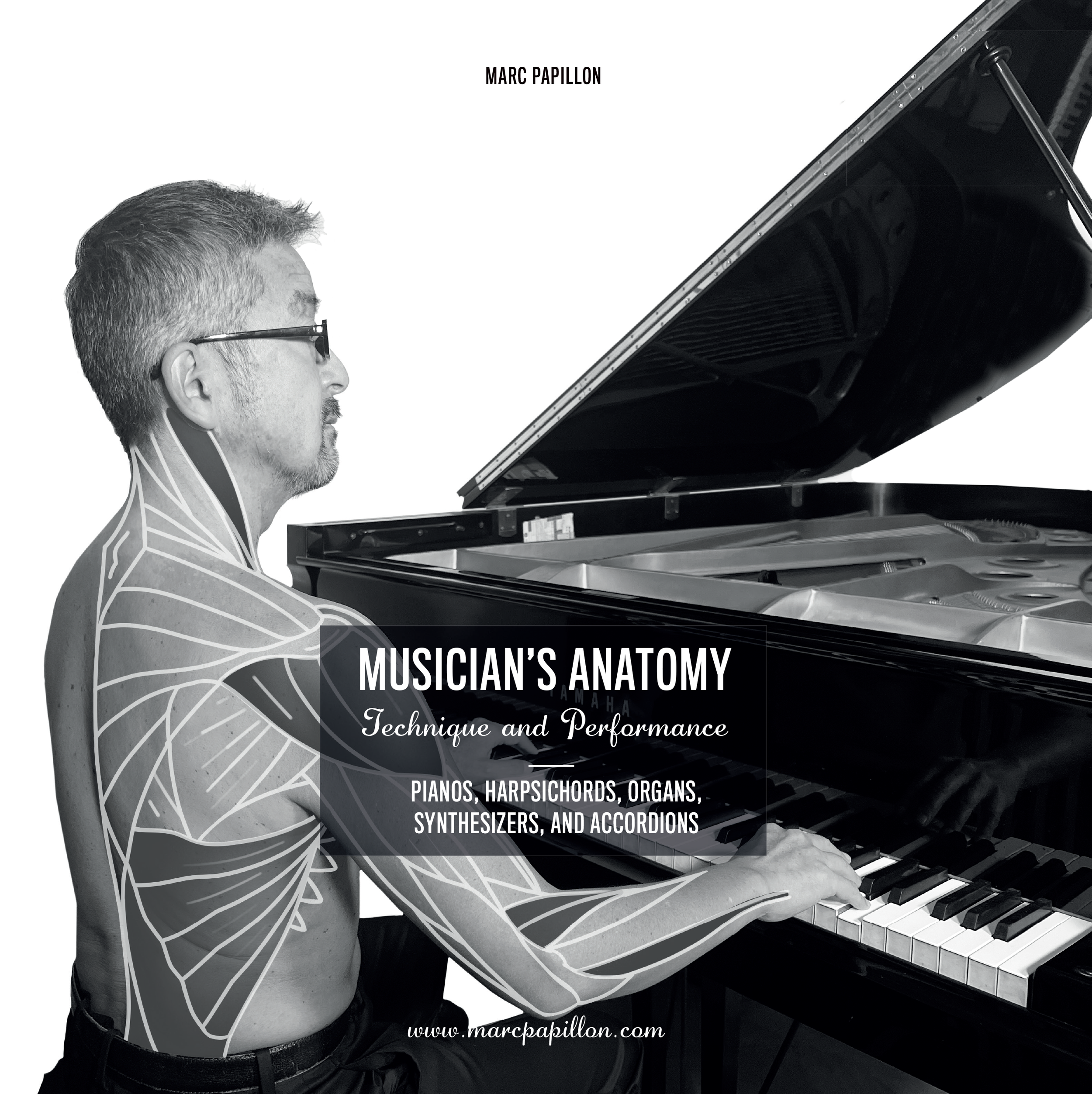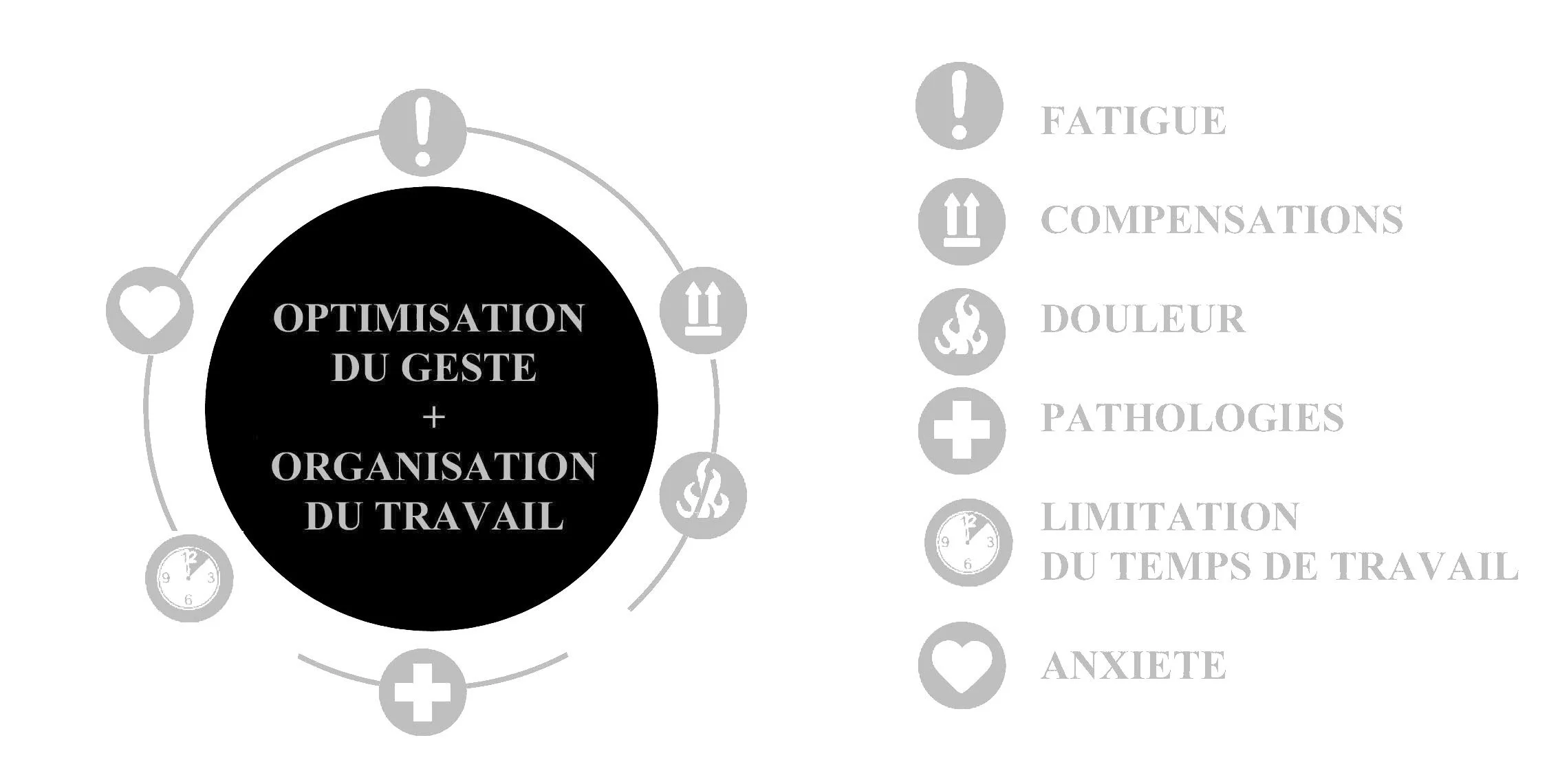The artist’S body
SELF-AWARENESS IN MOTION
I support artists
in their professional lives since 1996.
A work in full consciousness linked with the functional anatomy.
Maybe I am not trying hard enough, maybe I am doing enough, but I do not hurt myself.
And if sometimes the pain comes, it is a sign that I listen to without amplifying it.
It is not normal to hurt yourself while playing and daily pain is depressing.
The pain persists despite your efforts because the real problem is relaxation.
The search for relaxation is the number one confusion in pedagogy.
Performing without pain is not something extreme.
I share my work and keep creating new tools every day for you, musician.
Hello, my name is MARC PAPILLON and I help artists to learn very quickly to be more efficient and to recognize and accept all the path already explored!
physiotherapist - trainer
Marc Papillon specializes in the human movement analysis.
He integrates and makes connections between anatomy, the functional analysis, the design and ergonomics of the musical instrument and cognitive and behavioural tools. He applies his research conclusions to the performance, the gesture optimization and the scenic representation. He works with musicians, actors and dancers.
Marc Papillon is coaching artists who wish to optimize their skills.
In 2003, he co-founded “la Clinique du Musicien et de la Performance Musicale” (Clinic of the Musician and the Musical Performance) in Paris and today meets musicians through courses. Marc works in collaboration with musicians who have clear and specific goals: A customized physical, technical, strategic and mental preparation. He is continuing Philippe Chamagne’s work since 1998, precursor of the musician’s rehabilitation. He contributes to clinical research in the medical, scientific and pedagogic fields among artists. During individual or group sessions, he intervenes in orchestras, conservatories and universities.
Functional dystonia is the most complex pathology of the musician, he is deeply inspired by it.
The repetition and a conscious integration through the body are the fundamental tools which Marc develops day after day.
Marc shares his research through writing. His first book “La main du pianiste” (The pianist’s hand) is published in 2001, Editions Alexitère, then “La main du guitariste” (The guitarist’s hand) is published in 2011. He also co-wrote several collective works and will soon publish «Anatomie du Musicien» (The musician’s anatomy) the first book of a long series.
Since 2011, Marc uses video recording as a medium of choice: with a catalog of more than 90 online workshops.
A simple way to carry on working throughout the world.
Sometimes, the musician integrates several functional errors at an earlier age: seeking an excessive physical relaxation leads to many compensations.
The shoulders, the wrists, the stomach, the thumbs, the tongue, the throat are the most targeted areas in this search of relaxation.
So many advices passed from generation to generation which maintain these confusions with consequences on the comfort when playing, on the velocity or the endurance.
Thanks to a more conscious approach of the functional anatomy, misconceptions have been progressively replaced.
The necessary tools to expression, velocity and joy of playing make the learning easier.
The enjoyment of learning music can be a real challenge, a path that can sometimes be long and intense.
The joy of playing is the consequence of a toned physique and a relaxed mind, contrary to a too relaxed physique and a too tense mind !!!
Functional Anatomy
The functional pathologies of the musician are well indexed today.
– Overused Syndrome (inflammatory or not),
⁃ Nerve Compressions,
⁃ Focal Dystonia,
Other disorders as much crippling also exist (not listed as pathologies):
– Painful Contractures,
– Difficulties Concentrating, Organizing,
– Negative Stress, Anxiety of Performance
“Tendinitis” : a word improperly used which entails many confusions.
These embarrassments can be disabling.
Sometimes, the musician just does not want to share his difficulties for fear of being considered incompetent.
Breaking the deadlock becomes a daily concern at the cost of a spontaneous and nice performance.
An optimization of the gesture and the sensations in respect with the functional anatomy is the basis of the technique and the expression.
If you hear or feel the advantages of these adjustments, the changes of habits can be quickly integrated.
Music, a physical and mental sensation
A comprehensive work of the physical and mental demands
and challenges of any kind of professional music
Making music is a contemplative, but also a physically and mentally demanding activity. Preparing both mentally and physically for a long career in the world of professional music is challenging and requires a deep examination of one's own mental and physical constitution. With Edition Artiste - ‘Anatomy of Musicians’, Marc Papillon has written a 10- volume book series that addresses precisely these needs. A long-awaited comprehensive reference work on performance and techniques in music – available here!
VIOLIN AND VIOLA
Prefaces by Philippe CHAMAGNE, physiotherapist
Petteri IIVONEN - Principal Soloist at the National
Orchestra of the Paris Opera
Cello, Viola da Gamba and Double Bass
Préfaces by Xavier GAGNEPAIN - Cellist and Educator
Etienne RENARD - Double Bassist
and Yves LE BELLEC - Hand Surgeon
TRUMPET, HORN, TROMBONE and TUBA
Prefaces by Philippe CHAMAGNE, physiotherapist
Petteri IIVONEN - Principal Soloist at the National
Orchestra of the Paris Opera
Drums and Percussion
Préfaces by Franck AGULHON, Drummers and Teachers
and Laurent BATAILLE - Drummers and Teachers
VOICE AND BEATBOX
Préfaces by Nathalie SOLENCE - Singer, Songwriter
and ALEXINH - Beatboxer, World Beatbox Champion
SAXOPHONES, CLARINETS, OBOES, BASSOONS
and FLUTES
Préfaces by Florent PUJUILA - Clarinettist, Teacher
Jacques TYS - Principal Oboist at the Paris Opera Orchestra, Teacher
GUITARS, BASSES, LUTES, UKULELES, MANDOLINS, OUDS, BANJOS, SITARS
AND BALALAIKAS
Préfaces by Gabriel NATILLA, guitarist, lute player and teacher.
PIANOS, HARPSICHORDS, ORGANS, SYNTHESIZERS, AND ACCORDIONS
Prefaces by Manuel ROCHEMAN - Jazz Pianist
Vincent LHERMET - Accordionist and professor at the C.N.S.M.D.P.
HARPS
Preface by Chloé DUCRAY - Harpist and Trainer
MUSICIAN, ACTOR,
DANCER and DIRECTEUR
Preface by Manon COMPARINI - Rider, Violinist and Trainer
The artist's body SELF-AWARENESS
The artiste’s body serves as a profound canvas for self-awareness. Through the act of creating, artists delve into their physicality, exploring how their bodies interact with the medium, space, and emotions. This embodiment influences their expression and connects deeply with the audience.
In various forms of art, the physical presence of the artist can evoke powerful responses. Dancers, for example, navigate the limits of their bodies, translating raw emotion into movement, while visual artists may incorporate their physicality into their work, using techniques that reflect their bodily experiences. Every brushstroke, every gesture, becomes an extension of self-awareness, merging the artist's internal world with external expression.
Self-awareness in this context also involves a mind-body connection. Artists often reflect on their surroundings, experiences, and personal histories, allowing these elements to manifest physically in their work. This introspection fosters a deeper understanding of identity, vulnerability, and authenticity, creating a space where both the artist and the audience can engage in a shared experience.
Ultimately, the relationship between the artist and their body is a dynamic interplay that enhances creativity and self-expression. This awareness not only shapes the artistic process but also invites viewers to reflect on their own perceptions of identity and the way they navigate the world.
The Hand
The hand is an incredible and complex structure.
Each day, you take the time to develop better feelings.
“Technically, the wrist stability is the key for to free the fingers.
But, the wrist “suppleness” is too often taught.”
An other example of confusion : the thumb “relaxation” is often sought.
However, the thumb is the most important finger on the hand, it contributes to the stability of the wrist and the palm.
The thumb stability, fixed or mobile, offers a leeway to the other fingers.”
These confusions disrupt the hand function and favour “tendinitis” and other malfunctions.
The loss of reference points and “good” sensations are obviously very anxiety-provoking.
Becoming aware of these confusions helps the gesture optimization, the recovery and also increases the joy of playing.
A sensitive, powerful and precise hand. Free, independent and agile fingers.
Mask and Lips
A stable mask, a relaxed jaw, flexibility of the lips and tongue control.
For the wind instrumentists, the search for a balance between the constrictor muscle (orbicular) and all the dilatator muscles is crucial.
If the dilatator muscles work in all directions (as the sun), the lowering muscles of the lips are too often neglected.
An other example, the lack of flexibility when producing a low frequency comes from an excessive relaxation of the mask.
This discomfort makes you compensate, creates unnecessary tension and fatigue.
We must remember that the quality of the mask and the lips depends on the dynamics of the tongue and respiration.
The tongue is directly related to the management of the air flow and avoids the compensation of the mask or the lips.
Focus on the mask only is a source of tension:
Your jaw is drawn tight, you clench your teeth, tense your neck muscles, your throat is closing.
The agonist/antagonist muscle balance of the mask can be disorganized.
If the lips compensate, they get tired and can overwork.
To optimize your mask or your lips, it is necessary to adjust your shoulders, your coronal plane “from toes to head”, your respiration and your tongue.
Vertical Axis – The back
A toned and relaxed “coronal plane”, from toes to head, stability, anchor and endurance.
In a seated position, on your feet, in motion or resting, our spine is part of our axis.
“I need to sit up straight” is a regular and tiring thought.
However, holding your head up and pulling your shoulders back is not right and causes fatigue.
Added to that a too low respiration causes inevitably lumbar or cervical tensions.
The tone is the key of a physical and mental relaxation.
Abdominal muscles (pelvis), back, feet, respiration, a tonic axis for a balanced head.
Do not fight anymore, play with gravity !
Horizontal Axis : The Shoulders
Powerful shoulders which release the lips and the hands.
Playing music means holding your arms suspended in a relatively immobile position.
Your shoulders and your neck are tired, you are trying to release them.
It is a common leitmotiv but by « relaxing » them you tense them!
Because the weight of the arms weighs on the musculature of the upper back.
An excessive relaxation tires the neck which get tense and the respiration is limited
When you pull your shoulders back, a painful stabbing pain between the shoulder blades sets in.
On the contrary, “held and engaged » shoulders release this stabbing pain, relieve the neck, prevent compensations of the mask and the hands and increase self-confidence.
Respiration and Emotions
Getting on stage with the difficulty of managing your emotions take away the joy of playing.
Playing without emotion (submerging) does not mean playing without musicality.
Develop your physical landmarks, those that anchor and stabilize you.
Mismanagement of emotions limits technical abilities and expression.
You limit your endurance and that is exactly what is stressing you.
So you have the choice to go on stage calmly, staying connected with your feelings or get lost in your emotions, it is one or the other.
Also, respiration is often used to manage emotions.
But, while you play music, a too low respiration (abdominal or deep or ventral or diaphragmatic) does not relax you.
Indeed, a ventral respiration makes the abdominals malfunction, tires the back muscles, the shoulders, or the lips.
These technical consequences quickly become very anxiety-provoking.
The “calm” allows to gather all the necessary technical elements to play.
A tonic PHYSIC and a relaxed MENTAL = Joy of Playing
PREVENTION AND OPTIMIZATION
Prevention is essential to avoid or reduce the apparition, development and seriousness
of functional pathologies that affect the youngest as well as the most experienced.
These days of training / coaching are given in your structures.
If you want, we build a program together.
The first day is dedicated to clarify these functional confusions.
We can continue for several days during the year with a simulation.
PHYSICAL, TECHNICAL, STRATEGIC AND MENTAL PREPARATION
Physical preparation (off- instrument)
The keys to a physical preparation before the performance (rehearsals, auditions, concerts, competitions).
Gain endurance, flexibility, reactivity, stability, strength, manage your body in space.
Technical preparation (with the instrument)
Make the link between instrumental technical requirements and respect of the functional anatomy:
Sound, vibrato, move your hand, tempi, nuances, air column, flexibility of the mask, attack etc.), allocating your efforts, save yourself…
Strategic preparation (work organization)
Learn how to organize your work time, your rest periods, your priorities, improve effectiveness…
An optimized strategy frees up time.
Mental preparation (State of mind)
Develop concentration, play self-assuredly in any circumstances with clear goals. A sophisticated and ergonomic approach develops the desired qualities, velocity, endurance and joy of playing.
You can contact me by e-mail or telephone, we will organize together the program of this coaching.
Marc Papillon
contact@marcpapillon.com
00 33 (0)6 62 23 61 03
Prevention days already given in the Conservatories and Orchestras of Europe and the rest of the world (Non-exhaustive list) :
Paris Opera Orchestra – Ile de France Orchestra – Radio Orchestra – National Orchestra – Orchestra of Ile de France – Orchestra of Québec – Orchestra de Conception – Orchestra of Santiago de Chile – Irkutsk Orchestra – Orchestra of the Pays de la Loire … Conservatory of Paris boroughs – Conservatory of Montreal – Conservatory of Tokyo – Royal Conservatory of Brussels – Conservatory of Geneva – Conservatory of Lisboa – Conservatory of Helsinki and without mentioning many conservatories in the different regions of Quebec and France ..
Fatigue
La fatigue vient de l’excès de relâchement.
La recherche de détente est la confusion N°1 en pédagogie.
Fatigue comes from an excessive relaxation.
The search for relaxation is the number one confusion in pedagogy.
compensations
Acharnement, forçage et perfectionnisme vous poussent à travailler plus. Perte de souplesse, crispations et compensations : un cercle vicieux.
Relentlessness, physical forcing and perfectionism push you to work more. Loss of flexibility, tensions and compensations: a vicious circle.
Douleur /Pain
Douleurs d’épaules, de dos, de coudes, de mains ou de lèvres…
(seule la dystonie de fonction n’est pas douloureuse)
Shoulder, back, elbows, hands or lips pain…
(only functional dystonia is not painful)
Pathologies
Surmenages musculaires / Overuse Synfrom
Compressions nerveuses / Nerve compressions
Dystonies de fonction / Focal dystonia
Limitation du temps de travail
Limitation of Working Time
Ne pas pouvoir jouer plus de 10 minutes…
Ne plus pouvoir jouer du tout et déprimer.
Not being able to play more than 10 minutes …
No longer being able to play at all and feel depressed.
Anxiété / Anxiety
Anxiété de performance ou anxiété généralisée :
Une mauvaise gestion des émotions fatigue énormément…
Anxiety of performance or generalized anxiety disorder:
Mismanagement of emotions is very tiring …
From learning to teaching, from re-education to optimization, through the rehabilitation of functional dystonia to the preparation of competitions and concerts,
these last 25 years of experience allow me today to go to the essential
and to offer you the best in the service of your art.
From Fatigue to Stop Performing
It is really frustrating not to be able to play more than 10 minutes without feeling an unbearable tension.
The necessary concentration is disrupted and your work seems less beneficial. You are working more to fill this gap and your motivation is no longer sufficient. Your demanding nature mixed with your perfectionism and the repetition of the gesture are the causes of many aches.
Pathologies take place and stop playing seems sometimes necessary which increases your anxiety. This interruption does not offer you the possibility to incorporate new habits, only resumption under certain conditions allows it. You incorporate much faster than you think the respect of your anatomy within your technique.
You finally come up for air.
Pass down music and pleasure of the effort
Sometimes the musician integrates functional errors very early: the search for an excessive physical relaxation leads to many compensations. The shoulders, the wrists, the stomach, the thumbs, the tongue are the most targeted areas in this search of relaxation.
So many advices passed from generation to generation which maintain these confusions with consequences on the comfort when playing, on the velocity or the endurance.
Thanks to a more conscious approach of the functional anatomy, misconceptions have been progressively replaced. The necessary tools to expression, velocity and joy of playing make the learning easier.
FROM PEDAGOGICAL CONFUSIONS TO A FUNCTIONAL ANATOMY
Instrumental and vocal didactics rapidly progress and can now rely on the functional anatomy.
It is essential to include this knowledge into pedagogy.
It is time to decipher these confusions and realize, for example, that immobility is one of the main causes of the functional pathologies of the musician.
The lack of ergonomics of gesture, perfectionism, forcing and neglecting breaks are all reasons which shows the importance of work organization.
Just like the repetitive work of the musician which is considered as a factor of hardship.
ERGONOMICS OF THE GESTURE FOR A BETTER ENDURANCE
Music involves repeated biomechanical solicitations, that may cause the abandonment of the practice or may strongly slow down it by weighing psychologically on the health.
The qualifying elements of repetitive work which are generally accepted as a factor of hardship are:
– the execution of repeated movements,
– a solicitation of the same joints and body segments,
– constrained realization (tempi, nuances, interpretation),
– during most of the working time.
A FUNCTIONAL ANATOMY AT THE SERVICE OF MUSIC
It does not mean to teach anatomy but to offer musicians shortcuts in response to problems encountered (back, neck or shoulder fatigue, hand-holding difficulties, of independence, of fingers, laxity, anxiety etc.).
The instrumental technique can be simplified by taking into account the functional anatomy.
These balances in the service of music must be preserved and optimized in order to play for a long time.
EMOTION MANAGEMENT AND RESPIRATION
Getting on stage with the difficulty of managing your emotions move you away from the joy of playing.
Playing without emotion (submerging) does not mean playing without musicality.
Develop your physical landmarks, those that anchor and stabilize you.
Mismanagement of emotions limits technical abilities and expression.
You limit your endurance and that is exactly what is stressing you.
So you have the choice to go on stage calmly, staying connected with your feelings or get lost in your emotions, it is one or the other.
Also, respiration is often used to manage emotions.
But, while you are performing, a too low respiration (abdominal or deep or ventral or diaphragmatic) does not relax you.
All these informations allow musicians to become more efficient in their practice.
STABILITY AND TONICITY: THE KEY OF RELAXATION
“Technically, wrist stability is the key to free the fingers.
But, the wrist “suppleness” is too often taught.”
Another example of confusion : the thumb “relaxation” is often sought.
However, the thumb is the most important finger on the hand, it contributes to the stability of the wrist and the palm.
The thumb stability, fixed or mobile, offers a leeway to the other fingers.”
The loss of reference points and “good” sensations are obviously very anxiety-provoking.
Becoming aware of these confusions helps the gesture optimization, the recovery and also increases the joy of playing.
These confusions disturb your hand function and favors »tendonitis » and other dysfunctions.
FUNCTIONAL DISORDERS
The functional pathologies of the musician are well indexed today.
– musculotendinous overwork syndromes (inflammatory or not),
– nerve compressions,
– functional dystonias.
Other disorders as much crippling also exist (not listed as pathologies):
– painful contractures,
– difficulties concentrating, organizing,
– negative stress, performance anxiety…
“Tendinitis” : a word improperly used which entails many confusions. These embarrassments can be disabling.
TONGUE AND RESPIRATION
An other example, the lack of flexibility when producing a low frequency comes from an excessive relaxation of the mask. This discomfort makes you compensate, creates unnecessary tension and fatigue.
We must remember that the quality of the mask and the lips depends on the dynamics of the tongue and the respiration. The tongue is directly related to the management of the air flow and avoids the compensation of the mask or the lips.
Focus on the mask itself is a source of tension:
– Your jaw is drawn tight, you clench your teeth, tense your neck muscles, your throat is closing.
– The agonist/antagonist muscle balance of the mask can be disorganized.
– If the lips compensate, they get tired and can overwork.

To maximize your mask or your lips, it is necessary to adjust your shoulders, your coronal plane “from toes to head”, your respiration and your tongue.
The artist’S body
SELF-AWARENESS in Motion
Neuro-Dynamic Reprogramming: Body and Motor Control
Improvisation, Sustainable Flexibility, and Cooperation






















